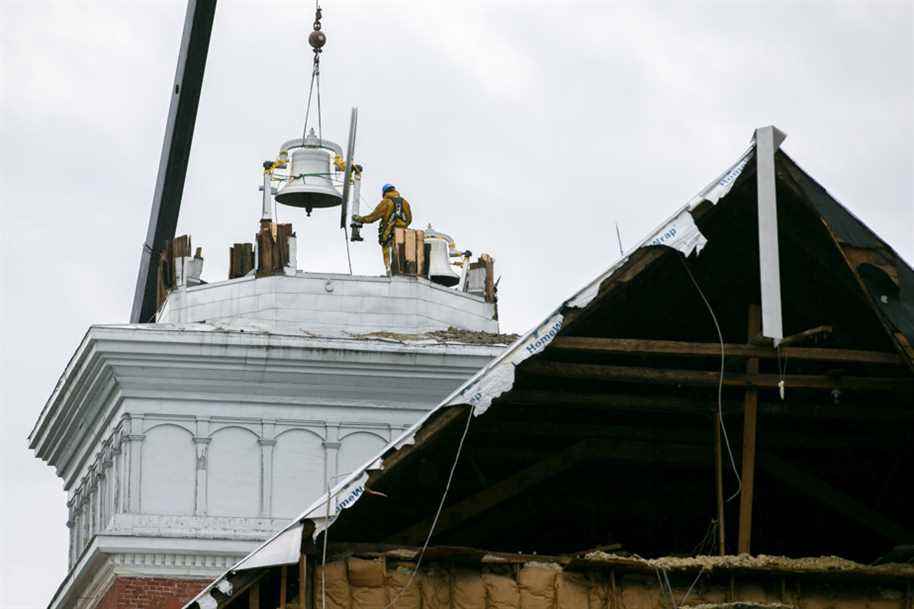December 2, 1972 appears in The duty the “Manifesto for the Safeguarding of Cultural Property”, signed by a hundred artists and intellectuals, including Jacques Brault, Nicole Brossard, Roland Giguère, Gérald Godin, Pauline Julien, Gaston Miron and Pierre Vadeboncœur. It vigorously denounces the negligence of the authorities towards the historical heritage of Quebec, attested not only by the then recent destruction of some fifteen churches and by the planned demolition of the parish complex of Sainte-Catherine-d’Alexandrie, but also by the threat of demolition of the former Patriotes-au-Pied-du-Courant prison at the corner of De Lorimier and Notre-Dame streets, in Montreal.
The signatories thus ask by what moral right the authorities “can erase witnesses of a period of resistance to colonialism of our people, such as that of 1837-1838 […]1 “. Scorching the silence of the intelligentsia and the bleak logic that leads our leaders to systematically shave the old in favor of the new, the signatories insist: “It should be enough to evoke the duty for a people to preserve its cultural heritage so that ‘we recognize that by sacking it, it is a part of itself that it destroys. And yet in these days of stupidity that we are going through, the powers of decision[ent] in the hands of short-sighted mercantis or business-minded politicians […]. ”
Today, fifty years after this manifesto, I am watching in the newspapers the few voices – too rare – which still rise to deplore the serial disappearances caused by a cocktail of ignorance, neglect or even administrative boondoggles. concealed.
[…] In front of some 3000 old buildings demolished each year in Quebec, the ethnologist Isabelle Picard is sorry: “It looks like a parade of permanent self-harm which cannot be named, as if society only managed to consolidate itself in front of the reassuring present of 21st century homese century2. “ Civil engineer Yves Lacourcière asks, in a letter to Nathalie Roy, Minister of Culture and Communications, ” [q]hen will the sacking of our built heritage stop? », Recalling rightly that it is not a renewable wealth […] Marc-André Bluteau, president of the Charlesbourg Historical Society, warns that “ [i]There is peril in the remains ”and deplores the“ pathetic disappearance of buildings however recognized for their heritage value3 “.
In its defense, the Caquista government clearly showed its interest in heritage in November 2018: in a rare gesture, Prime Minister François Legault, doubled by mayor Régis Labeaume, then present with great pomp, during a press conference at the Musée de la civilization, which seems to be the very first fortifications in Quebec, dated 1693. Legault embroiders a whole survival story around these exhumed remains of our good old French-Canadian clay: “To go and see these remains, I find that very touching. It inspires me. This confirms that our ancestors, those who founded New France more than 400 years ago, worked hard under difficult conditions. We managed to preserve this nation that speaks French4. “
The magnitude of this announcement has left several archaeologists a little dazed. Not to mention the researchers from Laval University who will discover, two years later, after careful expertise, that the famous palisades are rather the remains of a stable or a secondary building of the kind dated 1775.5. In terms of heritage preservation, there is something eloquent in these occasional media jolts by our elected officials. Most of the time, they take on the air of blind rendezvous with History.
What are the causes of this galloping trivialization of our cities and this abrasive amnesia that gnaws at them? Who orchestrates these demolitions which leave them anemic, almost bloodless of all traces of the past? There are of course the weak laws, the lack of coherence and long-term vision of our public policies. […]. There are obviously the starving means and the lack of resources of the cities. […] There is this logic of making the most of space that prevails everywhere. There is the omnipotence and impunity of the promoters, the dismay of the small owners left to their own devices, […] the convenient logic of “better than nothing”.
I wanted this essay inhabited by these images of demolitions and reconstructions in pasteboard, an essay full of transplanting and off-screen, embroidered images, scattered notes and memories. The figures, the points of intensity and the paradoxes that characterize our relationship to the built are declined. […]. This book questions our way of living, of projecting ourselves, of living together in this space that escapes us from all sides.
1. Collective, “Manifesto for the Safeguarding of Cultural Property”, The duty, 2 December 1972.
2. Isabelle Picard, “Heritage: the privilege of the past”, Press, September 25, 2019.
3. Yves Lacourcière, “When will the sacking of our built heritage end? “, Press, July 4, 2019.
4. “Fortifications of 1693 discovered in excellent condition in Quebec”, Radio-Canada, November 6, 2018.
5. Sébastien Tanguay, “The palisade of 1693 would neither be a palisade, nor dated 1693”, Radio-Canada, January 19, 2020.

The habit of ruins
The coronation of oblivion and ugliness in Quebec
Marie-Helene Voyer
Lux Éditeur, November 2021
216 pages
Who is Marie-Hélène Voyer?

PHOTO PROVIDED BY THE EDITOR
Marie-Helene Voyer
Professor of literature at the Cegep de Rimouski, Marie-Hélène Voyer published Habitat Expo (La Peuplade, 2018), his first collection of poetry, as well as the book Terrains vague – Poetics of uncertain space in contemporary French and Quebecois novels (Nota Bene, 2019).
